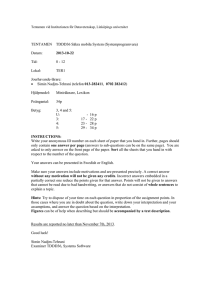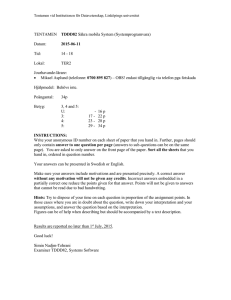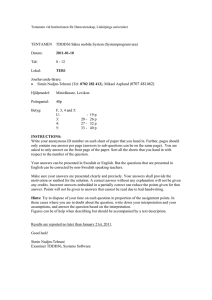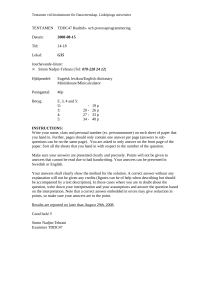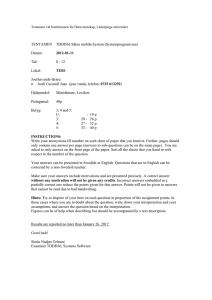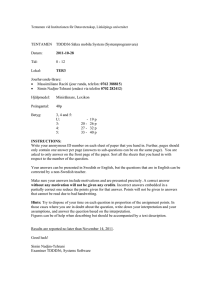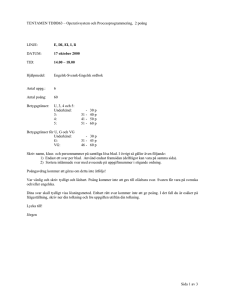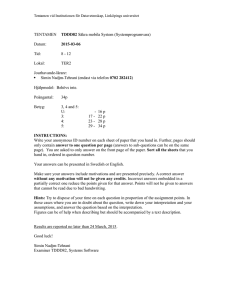TDDD82 Date: Time: 14 - 18
advertisement
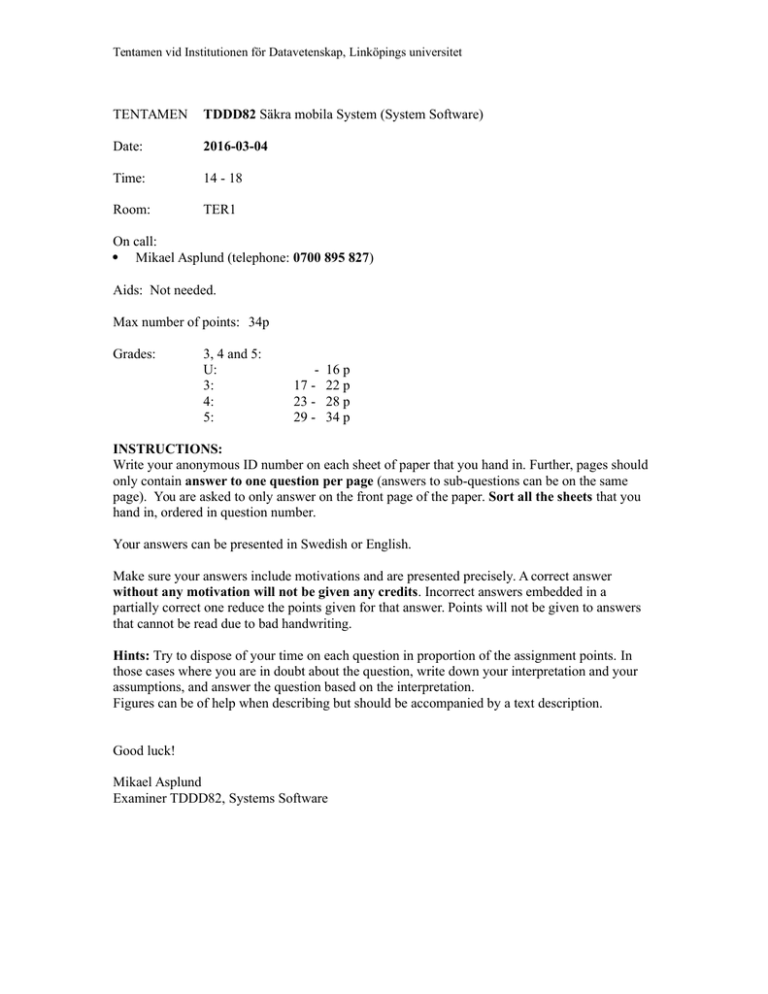
Tentamen vid Institutionen för Datavetenskap, Linköpings universitet
TENTAMEN
TDDD82 Säkra mobila System (System Software)
Date:
2016-03-04
Time:
14 - 18
Room:
TER1
On call:
Mikael Asplund (telephone: 0700 895 827)
Aids: Not needed.
Max number of points: 34p
Grades:
3, 4 and 5:
U:
3:
4:
5:
17 23 29 -
16 p
22 p
28 p
34 p
INSTRUCTIONS:
Write your anonymous ID number on each sheet of paper that you hand in. Further, pages should
only contain answer to one question per page (answers to sub-questions can be on the same
page). You are asked to only answer on the front page of the paper. Sort all the sheets that you
hand in, ordered in question number.
Your answers can be presented in Swedish or English.
Make sure your answers include motivations and are presented precisely. A correct answer
without any motivation will not be given any credits. Incorrect answers embedded in a
partially correct one reduce the points given for that answer. Points will not be given to answers
that cannot be read due to bad handwriting.
Hints: Try to dispose of your time on each question in proportion of the assignment points. In
those cases where you are in doubt about the question, write down your interpretation and your
assumptions, and answer the question based on the interpretation.
Figures can be of help when describing but should be accompanied by a text description.
Good luck!
Mikael Asplund
Examiner TDDD82, Systems Software
Tentamen vid Institutionen för Datavetenskap, Linköpings universitet
Q1 (17 points):
Consider the following pseudo code for a program that is composed by the processes P1 and P2.
Assume that every statement in the code is atomic and that all possible interleavings are
equally likely to occur.
1.1: Process P1 {
1.2:
X := 1
1.3:
Y := 2
1.4:
if (X == Y) {
1.5:
print(“1”)
1.6:
}
1.7: }
2.1: Process P2 {
2.2:
X := 2
2.3:
Y := 2
2.4:
if (Y == X) {
2.5:
print(“2”)
2.6:
}
2.7: }
a) How many possible interleavings can occur when running the program? (1 point)
b) What are the possible outputs of the program that can actually occur? Motivate each
output why or why not it is a possible output of the program.
(3 points)
c) What is the probability that the output of the program is ”21”?
(4 points)
d) Use semaphores to ensure that the output of the program is ”12”.
(2 points)
e) Explain the use of condition variables in monitors with the help of an example.
(2 points)
f) Briefly explain each of the Coffman conditions.
(2 points)
g) Consider the following resource allocation problem in a system with three resources (R1R3), and four processes (P1-P4). The table indicates the currently allocated resources and
in parenthesis the maximum possible demand (e.g., P1 currently has 2 instances of
resource R1 and can at most request a total of 3 instances).
Resource R1
Resource R2
Resource R3
P1
2 (3)
2 (3)
0 (1)
P2
1 (1)
0 (2)
0 (0)
P3
1 (1)
2 (2)
0 (1)
P4
0 (4)
1 (1)
0 (1)
In total there are 4 instances of resource R1, 7 instances of resource R2, and 1 instance of
resource R3. Use Banker's algorithm to determine if the request from P2 of 2 instances of
resource R2 should be granted.
(3 points)
Tentamen vid Institutionen för Datavetenskap, Linköpings universitet
Q2 (8 points):
a) The figure below is a simplified reconstruction from a figure in the Netflix Tech blog
http://techblog.netflix.com/2012/06/annoucing-archaius-dynamic-properties.html
with the description that it ”shows a hypothetical simplistic overview of a typical
deployment architecture at Netflix”. Explain how this architecture makes use of horizontal
and vertical distribution (note that service 0 and 1 are really different services, not just copies
of the same service).
(3 points)
Client1
Client2
Client3
Client4
Amazon ELBs
Amazon
S3
Edge service 0
Mid tier
service 0
Cache
Cassandra
Edge service 1
Mid tier
service 1
Edge service 2
Mid tier
service 2
Tentamen vid Institutionen för Datavetenskap, Linköpings universitet
b) Explain why it might be appropriate to use an asynchronous system model when designing a
distributed system.
(2 points)
c) Use Lamport clocks to give timestamps to the events (a-g) in the figure below (assume each
node starts with a clock value 0):
b
A
B
d
e
f
a
C
g
c
(3 points)
Q3 (5 points):
a) Jitter is an important QoS metric in network and real-time application. Provide two
alternative ways do define jitter.
(2 points)
b) Consider a system for monitoring the health of elderly patients in their homes. For each of the
following system requirements take a stand on whether it is a functional or extra-functional
requirement (remember to motivate your answer):
◦ If the patient pushes the alarm button, then emergency services should be notified.
◦ The expected frequency of an alarm not reaching Emergency services due to network
problems should be less than once every 10 years.
◦ Personal information of patients should only be accessible by the authorised medical
personnel.
(3 points)
Q4 (4 points):
Use the terminology from IFIP Working Group 10.4 to analyse the fault-error-failure chain in the
example below. Classify the fault as permanent/transient/intermittent”.
”While driving in autonomous mode, a Google self-driving car was involved in a minor accident
with a public transit bus in California on Valentine’s Day, according to an accident report (PDF)
filed with the California Department of Motor Vehicles (DMV):
A Google Lexus-model autonomous vehicle (“Google AV”) was traveling in autonomous mode
eastbound on El Camino Real in Mountain View in the far right-hand lane approaching the Castro
St. intersection. As the Google AV approached the intersection, it signaled its intent to make a
right turn on red onto Castro St. The Google AV then moved to the right-hand side of the lane to
pass traffic in the same lane that was stopped at the intersection and proceeding straight.
However, the Google AV had to come to a stop and go around sandbags positioned around a
storm drain that were blocking its path. When the light turned green, traffic in the lane continued
past the Google AV. After a few cars had passed, the Google AV began to proceed back into the
center of the lane and pass the sandbags. A public transit bus was approaching from behind.
Tentamen vid Institutionen för Datavetenskap, Linköpings universitet
The Google AV test driver saw the bus approaching the left side mirror but believed the bus
would stop or slow to allow the Google AV to continue. Approximately three seconds later, as the
Google AV was reentering the center of the lane it made contact with the side of the bus. The
Google AV was operating in autonomous mode and traveling less than 2 mph, and the bus was
traveling at about 15 mph at the time of contact.
The Google AV sustained body damage to the left front fender, the left front wheel and one of its
driver’s-side sensors. There no injuries reported at the scene.”
(4 points)
Tentamen vid Institutionen för Datavetenskap, Linköpings universitet
Glossary: English to Swedish
atomic – atomisk (oavbrytbar)
request – begäran
availability – tillgänglighet
response time – responstid
avoid – undvika
safety – säkerhet
bandwidth – bandbredd
scheduler – schemaläggare
broker – medlare
security – säkerhet
clock drift – klockdrift
serialisable - serialiserbar
concurrency – samtidighet
shaping - formning
consistency – konsistens
shared memory – gemensamt minne
deadlock – låsning (baklås)
starvation – svält
delay – fördröjning
sufficient condition- tillräckligt villkor
deliberate – avsiktlig
synchronisation – synkronisering
dependability – pålitlighet
system call – systemanrop
diversity – mångfald
thread - tråd
error – felyttring
throughput – genomströmning
event – händelse
trace – spår
failure – haveri
transparency – transparens
fault – felkälla
trust – tillit
fault tolerance – feltolerans
validation – validering
forecast – förutse
verification - verifiering
inheritance – arv
vulnerability - sårbarhet
integrity – dataintegritet
interleavings – sammanflätningar
interoperability – interoperabilitet
intrusion – intrång
latency - latens
maintainability – reparerbarhet
malicious - illvillig
middleware - mellanvara
mutual exclusion – ömsesidig uteslutning
necessary condition – nödvändigt villkor
non-functional property – ickefunktionell egenskap
omission – utelämnande
performance – prestanda
preemptible – avbrytbar
prevent – förebygga
quality of service – tjänstekvalitet
race condition – kapplöpningstillstånd
release - släppning
reliability – tillförlitlighet
rendundancy – redundans
replica – kopia
replication – replikering
Tentamen vid Institutionen för Datavetenskap, Linköpings universitet
Swedish – English
arv - inheritance
atomisk (oavbrytbar) – atomic
avbrytbar - preemptible
avsiktlig - deliberate
bandbredd - bandwidth
begäran - request
dataintegritet - integrity
felkälla - fault
feltolerans - fault tolerance
felyttring - error
fördröjning - delay
förebygga - prevent
formning - shaping
förutse - forecast
gemensamt minne - shared memory
genomströmning - throughput
händelse - event
haveri - failure
ickefunktionell egenskap - non-functional
property
illvillig - malicious
interoperabilitet - interoperability
intrång – intrusion
kapplöpningstillstånd – race condition
klockdrift - clock drift
konsistens - consistency
kopia - replica
låsning (baklås) - deadlock
latens - latency
mångfald - diversity
medlare - broker
mellanvara - middleware
nödvändigt villkor - necessary condition
ömsesidig uteslutning - mutual exclusion
pålitlighet - dependability
prestanda - performance
redundans - rendundancy
reparerbarhet - maintainability
replikering - replication
responstid - response time
säkerhet - safety
säkerhet - security
sammanflätningar - interleavings
samtidighet - concurrency
sårbarhet - vulnerability
schemaläggare - scheduler
serialiserbar - serialisable
släppning – release
spår - trace
svält - starvation
synkronisering - synchronisation
systemanrop - system call
tillförlitlighet - reliability
tillgänglighet - availability
tillit - trust
tillräckligt villkor - sufficient condition
tjänstekvalitet - quality of service
tråd - thread
transparens - transparency
undvika - avoid
utelämnande - omission
validering - validation
verifiering - verification
